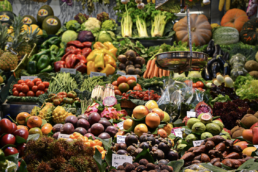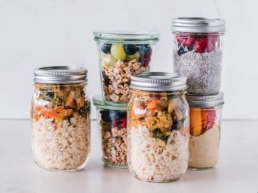By Taylor Winkel, First Mile Care DPP Coach and Registered Dietitian
For anyone struggling to make lifestyle changes as part of the First Mile Care Diabetes Prevention Program (DPP), the period between Halloween and New Year’s is a minefield. Those new routines you established involving careful meal planning, mindful eating, daily exercise, and good sleep hygiene will almost certainly be interrupted. No question but that it requires steely determination and focus to stick to your health and fitness goals and survive the holiday season.
When we think about indulging in big holiday meals, our go-to dishes are often traditional recipes handed down through the generations. These may be things you don’t eat at any other time of the year but you eat them now because they evoke memories of people and times gone by.
Every November, newspaper and TV websites are full of maps of the regional preferences of Americans for their holiday side dishes. An old-fashioned Thanksgiving table might offer cranberry sauce, turkey, stuffing, sweet potatoes, mashed potatoes, coleslaw, macaroni and cheese, corn, biscuits, pumpkin pie, etc. (Change turkey to ham and pumpkin pie to mince, and you have a classic Christmas meal.) These are mainly high-fat, high-starch food items — hardly surprising since Americans famously love their carbs!
If you are following the CDC meal planning guidelines for the Diabetes Prevention Program, your First Mile Care coaches have explained that the “ideal” balanced plate is 50% non-starchy vegetables (salad greens, broccoli, cauliflower, cabbage, green beans, carrots, et.), 25% protein foods (chicken, turkey, eggs, tofu, etc.), and 25% carb foods like starchy vegetables, grains, rice, pasta, fruit, yogurt, etc. (Plus, it’s essential to include some fats in the form of nuts, olives, avocados, coconut oil, and olive oil.) So it can be really challenging to make a balanced plate from the classic holiday menu as mentioned above! And then you must also confront the temptation of large portions and multiple servings …
But why not switch it up? What if holiday meal planning involves preparing some of these dishes in a healthier way, or offering healthier — but equally delicious — substitutes? It may not be the way grandma fixed it, but you could even enjoy it more.
Different, but just as good
The traditional dishes tend to be very high in saturated fats like butter, high in sodium, high in added sugars, and have high-fat creams — oftentimes hidden in foods that are seemingly benign. For example, you might consider Aunt Irma’s’ green bean casserole as healthy because, hey, it has veggies! Unfortunately, she stirs in quantities of butter and cream which make it soooo tasty but also result in a high-calorie, high-fat side dish.
Having dishes with healthier ingredients allows you to avoid overeating high-sodium, high-fat foods with excessive calories. You can also better manage your blood sugar level and keep it from spiking and crashing. With healthier side dishes, you can eat less and still feel satisfied — and it will usually “cost” you fewer calories. This can also stop you from feeling guilty about what or how much you ate (though you should never have to feel guilty to begin with!).
Depending on the dish, you can replace fat with a healthier alternative. Instead of butter, use olive oil, applesauce, avocado, or even pumpkin puree, which focuses on more of the healthy fats we want in our diet and decreases the unsaturated fats. Other healthy swaps include whole wheat flour instead of all-purpose flour, coconut sugar rather than white sugar, and pure maple syrup as a sweetener.
Guilt-free deliciousness
Below is my suggestion for some healthy dishes to consider serving during the upcoming holiday season, or healthier ways to prepare traditional holiday items. I’ve included a few links to recipes, too.
APPETIZERS
Finger foods: These are the best appetizers as they are easy and stress-free, leaving you more time to focus on preparing your main meal. Emphasize raw fruit and vegetables with some healthy dips like hummus, or a homemade yogurt ranch or dill dip — e.g., celery and cucumber sticks, baby carrots, bell pepper strips, broccoli and cauliflower florets, fennel, baby corn, and asparagus spears. Accompany the crudités with dishes of nuts, whole grain crackers, pickles, olives, and some cheeses.
Soup: Homemade soup is a good choice as a healthy appetizer, as a vegetable soup can add more nutrients to a meal. Butternut squash soup is packed with fiber, vitamin A, and potassium. My go-to recipe uses wholesome ingredients and also adds in some beans for even more added fiber.
MAIN COURSE
Turkey: Turkey is a lean protein, but how you prepare it can determine how healthy it is. Baked, barbecued, or broiled is fine, but do not deep fry the bird! Using low-sodium broth, fresh oranges and lemons, and fresh herbs can infuse the turkey with a really good flavor. Turkey can be pretty dry without butter, but try to limit butter to two sticks at most.
Vegan pot pie: Instead of offering a second meat option, think about offering a vegan or vegetarian dish that can appeal to everyone. This recipe for a vegan pot pie can be made healthier by using a low-sodium broth, and substituting whole wheat flour for added nutrients instead of all-purpose flour. You can also add tofu or tempeh for more protein.
SIDE DISHES
Brown rice stuffing or veggie stuffing: Though stuffing is delicious, it can become very high in calories after adding a lot of meat to it. My suggestion is to do one of two things: Make a brown rice stuffing, or add extra celery and onions to a traditional recipe instead of meat. Brown rice is a healthier ingredient over white rice and white bread because it is less processed, meaning it still has the bran and germ (outer layer) which holds the vitamins and minerals. In highly processed foods like white rice and white bread, those nutrients are stripped away.
Quinoa salad: Quinoa salad is always a good way to go. Your standard salad is sometimes not very filling, so people often add a protein source. Quinoa is considered a superfood — a complete protein. That means it has all of our essential amino acids, just as a meat source such as chicken does.
Spinach, kale, and brussel sprout salad: You can never go wrong with more greens. This recipe can replace something such as coleslaw, and instead of having a mayonnaise-based dressing, offers an oil and vinegar dressing which is a healthier alternative. Having a sweeter salad option can also help satisfy your sweet tooth, so perhaps you’ll be less tempted by the desserts on offer.
Honey-glazed carrots and broccoli: You want vegetable options for your healthier holiday meal, and offering something with natural sweetness may, again, lessened sugar cravings for dessert.
Cranberries: Lastly, use a homemade cranberry sauce versus a canned sauce or jelly, as the canned version can be very high in added sugars. When you make cranberry sauce at home like the one in this recipe, you’re in control of the amount of added sugar and can naturally sweeten it. You can even give it your own touch with some lemon or orange zest.
DESSERT
A traditional favorite like pumpkin pie is still on the table if you make it a tad healthier. You can naturally sweeten it with maple syrup and coconut sugar. When making the crust, think about healthier ingredients like almond flour or whole wheat flour. Even better, the recipe here can be made without crust or as pumpkin pie bars, which will have the added benefit of making the dessert lower in calories. This recipe is even dairy-free for those who are lactose-intolerant.
BEVERAGES
Avoid alcohol, syrupy coffee, and sugary beverages like lemonade, soda pop, and sweet tea. Instead, focus on hydrating, especially when you still feel hungry after already eating. It can be easy to mistake thirst for hunger, so grab your one plate of food, hydrate yourself with plain water or an herbal infusion, and then digest your meal for 20 minutes. If after that 20 minutes you still feel hungry, then grab another serving, but chances are you will find you feel full.
Are you salivating yet? Good, I’ve accomplished my goal! Your key takeaway from reading this article is that healthy does not have to mean boring. Healthy eating can be just as enticing to your taste buds as your traditional high-fat, high-calorie holiday dishes. Go ahead, create some new traditions! Your body will thank you.
To learn more about how you can benefit from the First Mile Care Diabetes Prevention Program, take the prediabetes risk test and get started today!



